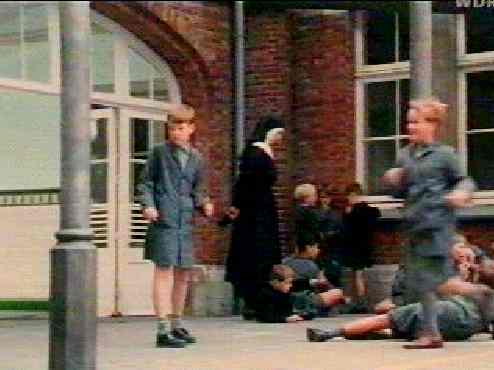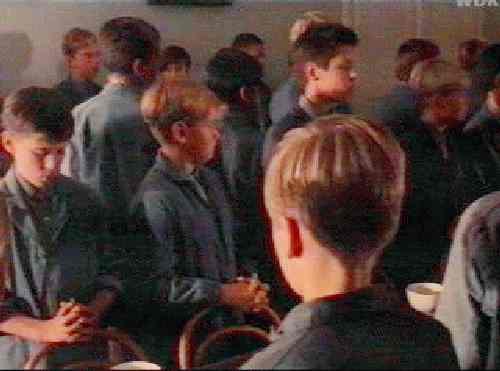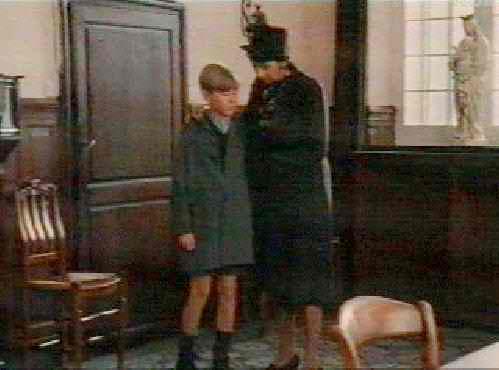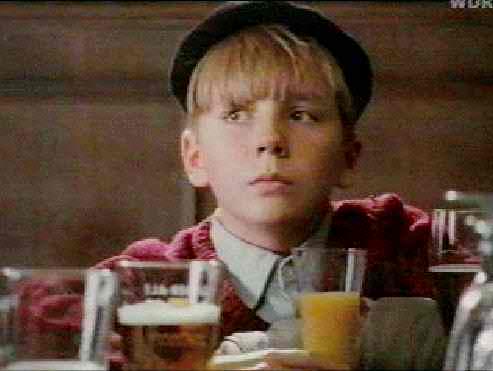
Figure 1.--This Belgian film shows school fashions in the 1940s after the end of World War II. It appears to be a catholic boarding school. All the children wear short pants and smocks. The boys appear to be on a recess break here.

Het Verdriet van Belgie ("The Sorrow of Belgium") is set during World War II (1939-45) at a Catholic boarding school. It is a school for younger boys and nuns are very much present and they wear the traditional habit. The boys look to be about 8 to 12 years of age. I'm not sure what kind of school is depicted. While English boys commonly went to boarding school beginning about age 8 years, I do not think it was nearly as common for younger boys to attend boarding school in Belgium and other continental countries. I thought at first that it was an orphanage for displaced children, but the boys look too well dressed for that. The book on which the film is based is about a boarding school. The film is set in Flanders, the Dutch speaking part of Belgium. The boys wear short pants and smocks. Both front and back opening smock styles can be seen, although the front buttoning ones appear most prevalent. This would date the film after World War II which suggests an error in the costuming. The back buttoning smocks would have been more common durin the War. The smocks are all the same blue color even though they are styled differently. They are also different lengths. Some are above the knee and some below the knee. The boys appear to wear rather long shorts. I think that in the late 1940s, shorter styled shorts might have been more common. Short pants suits and berets are also seen. Generally the clothing style appear to be less formal than in a British school at the same time. None of the boys wear suits or ties. I'm not even sure if they are wearing unoforms under their smocks as the smocks cover up the clothing that they are wearing. Some boys wear kneesocks. The boys all seem to be wearing leather shoes. I do not see any sandals. Some scences from the film appear to show a new boy arriving. He is very well dressed in a suit and white shirt, but does not wear a tie.
Het Verdriet van Belgie ("The Sorrows of Belgium") is based on a book written by the famous Belgian author Hugo Claus. The book was published in 1983. The German edition is titled "Der Kummer von Flandern".
The film is set in Flanders, the Dutch speaking part of Belgium. Locations of the film are the catholic boarding school (het gesticht) in a place called Walle and his hometown Bastegem, both in Belgium.
Setting the film in Flanders during the German World War II occupation raises some intersting aspects to this film. Movies usually paint a simplistic brush of the German occupation of European countries during World War II, suggesting that the entire population were horified with the Germans and, except for a few colaborators, resisted or at least objected to the German invasions. The actual situation is much more complex. Several countries welcomed the Germans. This was particularly true in countries the Soviets had previously seized (the Baltic countries) or actual areas of the Soviet Union (the Ukraine). There were portions of the population in other countries such as the Croats in Yugoslavia that to varying degrees supported or cloaborated with the Germans. This was particularly ture in 1940 and 1941 where it looked to most people like the Germans had won the war and that NAZIism was the wave of the future. There was already considerable pro-German sentiment in Flanders where many objected to the domination of French-speaking Waloons in pre-war Belgium. The Germans for their part regarded people in Nordic countries as fellow Aryans. This extended to the Flemish. Germans living in Flanders before the war organized Hitler Youth units. After the occupation the Germans outlawed Scouting and the approved collaborationist political organization in both Flanders and Waloonia organized a pro-German youth movement along the lines of the Hitler Youth.
The boy playing the leading role in the film, for example, is seen in some scenes wearing a Hitler Youth uniform, or more likely the Flemish youth movement uniform. It is not often a boy in an occupied country is pictured joining the Hitler Youth or pro-German youth group. Compare this with Au revoir les infants. There were French nationalist youth groups in France during the occupation. Both films were set at the same time. Yet it is unlikely that a boy at the French school would have joined the Vichy sponsored youth movement. The topic of nationalist and NAZI-approved youth organizations is dealt with in the Historic Boys' Uniform Site. This information has proven difficult to obtain, but HBU has quite a bit of information on Flanders.

Figure 3.--The boys prepare to say grace before dinner. Notice that almost all these boys wear front-buttoning smocks. HBC doubts this would have been the case in the early 1940s. |
Hugo Claus' book Het Verdriet van Belgie ("The Sorrows of Belgium") is an autobiographical fictional account about life in Flanders before and after World War II, but mostly during the German occupation. Claus explanins how life went on normally for most people during the German occupation. Belgium unlike the Neherlands had a relatively small Jewish population and the Belgians, especially the Flemmish, were looked on by the NAZIs as potentially valuable racial stock. Thus unlike the occupied countries to the East, most Belgians muddled through the NAZI occupation and life went on in Belgium surprisingly unchanged. The book centers on Louis Seynaeve and his family. Louis is a student at a catholic boarding school. When we first meet Louis, his interested are those of any child and he is oblivious to the fact that the war is unravelling around him. He forms a secrdet club at school. The NAZI horror is kept below the surface and rarely touches Louis. A teacher disappears and then reapperas with missing teath. Shortages and conscription for labor service in the Reich are the major concerns of most adults as the War progresses and turns against Germany. The book in large measure describes how the Belgians collaborated with the Germans during the occupation, but it is not an acusatory book. Claus' view is that there was really little choice for most Belgians. The book shows the contradictory threads running through the lives of most Belgians during the occupation. Louis joins the NAZI-approved youth group, I think it would have been the Youth of Delag in Flanders. Even so, he delights in reading books banned by the NAZIs.
The pictures are from a film made in the 1990s, set in wartime Belgium. HBC believes that the costuming is not precisely appropriate for the 1940s. It is likely that during the War that back-buttoning smocks would have been more in evidence rather than the front-buttoning smocks the boys are pictured as wearing. The costume designer appears to have used smocks easily available in the 1990s rather than smocks appropriate for the era. Also all the boys wear rather longs shorts, some even below the knee. This is probably another error in the costuming.

Figure 4.--Louis is told by his mother that he will have to leave school. |
The action takes place at a Catholic boarding school. It is a school for younger boys and nuns are very much present and they wear the traditional habit. The look to be about 8 to 12 years of age. I'm not sure what kind of school is depicted. While English boys commonly went to boarding school beginning about age 8 years, I do not think it was nearly as common for younger boys to attend boarding school in Belgium and other continental countries. I thought at first it was an orphanage for displaced children, but the boys look too well dressed for that. The book on which the film is based is clearly about a boarding school. A HBC reader explains, "The setting is a boarding school, not an orphanage. Up until the 1960s in Belgium it was common practice for the upper or affluent middle class parents to send their children to a boarding school. Primary school in Belgium starts at the age of 6, for 6 years; secundary school is another 6 years." A Belgium is a Catholic country, almost all private schools were Catholic--most opperated by the Catholic Church.
The students look to be primary school age. All the boys look to be in the 8-12 year age range, rather like an English prep school. The grounds and buildings at the school look rather garnd for a primary school. Perhaps this was the junior section of a college or secondary school.
Het Verdriet van Belgie is about the 11 year old boy Louis Sevenage. The first part of the book (by far the largest part of the film) is situated in the autumn of 1939/spring 1940 just as the Germans are invading the country. The second part 1940-1948 covers the German occuoation, liberation, and post-War era. The book is really a "Bildungsroman" following the physical and intellectual development of Louis. The film concentrates on 11-12 year old Louis living in the boarding school with his friends and being home with his family: rather superficial. The plot line follows the every day life of Louis and his family. As the images shows the boy playing the leading role is shown leaving the school. He can be seen in his dress clothes leaving school with his mother, this is presumably a part of the plot. Interesting that he takes off his uniform before leaving school. At a British school he probably would have worn his uniform home and changed when he got there. I do not know why, but for some reason, he has to leave and is saying good-bye to his friend sitting on the wall. This is the same boy he was involved in a fight with in one of the other pictures. A good bit of the film centers on Luis after he leaves school.
The boys at the school all wear short pants and smocks. Uniforms were not as common for school children on the continent as it they were in Britain. This school did have a uniform but other than a smock it was quite a simple one--a grey sweater and grey short pants. The uniform actually looks rather British. I'm not sure how common school uniforms were in Belgium before and during the war. This appears to have been a private school, presumably for boys from affluent families. Uniforms may have been more common at such schools.
The boys do not wear a beret as part of their uniform, but some boys do wear berets.
Both front and back opening smock styles can be seen, although the front buttoning ones appear most prevalent. This helps date the film as before World War II (1939-45), the back buttoning smocks would have been more common. The smocks are all the same blue color even though they are styled differently. They are also different lengths. Some are above the knee and some below the knee.
Ties are not required at the school.
Some of the boys wear sweaters. The uniform at the school was a grey sweater with red trim. They all seem to wear grey sleeveless jumpers with red piping when they go to church because they do not wear their smocks to church.
The boys all wear grey shirts, rather like a British school. Some boys have buttoned their collars. I'm not sure that this was required. I knew British school boys wore grey shirts. They didn't show ink and other stains as much as white shirts. I didn't know grey shirts were also worn on the continent.
The boys appear to wear rather long shorts. I think that in the late 1940s, shorter styled shorts might have been more common. Compare the shorts the boys in this film wear with the shorts normally worn by Hitler Youth boys.

Figure 7.--Louis is shown here wearing a beret with a maroon sweater. |
Short pants suits are also seen. Some scences from the film appear to show a new boy arriving. He is very well dressed in a suit and white shirt, but does not wear a tie.
The boys at the school wear kneesocks. Some of the boys have let their kneesocks fall down, but they all appear to weak kneesocks as part of their school uniform. The new boy just arriving wears short socks.
The boys all seem to be wearing leather shoes. I do not see any sandals.
At bedtime the boys wear white night-gowns.
The makers of this film seem to think it necessary for boys to change out of their uniform when leaving school. This was not the case in actual Belgian schools. A HBC contributor reports that he always had to wear his uniform when traveling to and from school. He disliked this very much as his school required short pants and the other school on the same rail line did not require short pants. He and hisd mates remember being teased by the other boys.
Generally the clothing style appear to be less formal than in a British school at the same time. None of the boys wear suits or ties. I'm not even sure if they are wearing uniforms under their smocks as the smocks cover up the clothing that they are wearing.
Navigate the Boys' Historical Clothing Web Site:
[Return to the Main alpahabetical Ha-Hl page]
[Return to the Main Belgian movie page]
[Return to the Main school movie page]
[Introduction]
[Activities]
[Biographies]
[Chronology]
[Clothing styles]
[Countries]
[Topics]
[Bibliographies]
[Contributions]
[FAQs]
[Glossaries]
[Satellite sites]
[Tools]
[Boys' Clothing Home]
